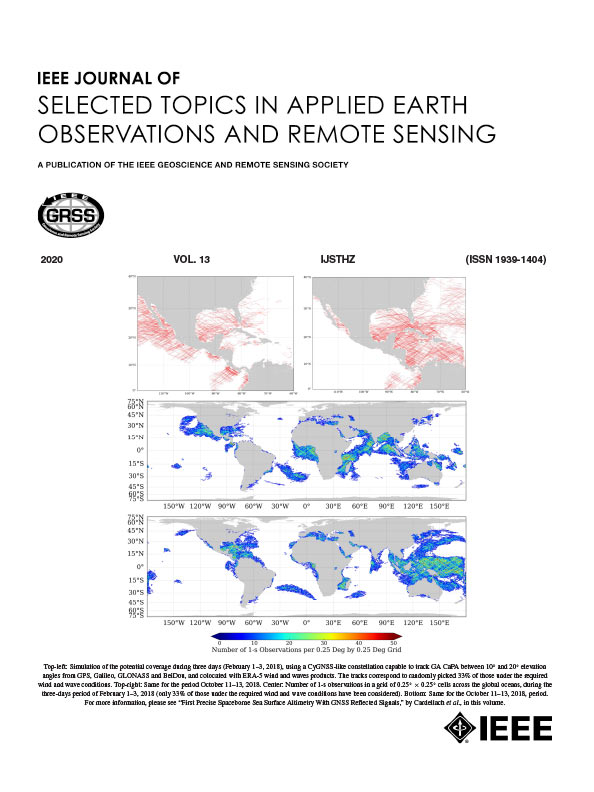CD-STMamba: Toward Remote Sensing Image Change Detection With Spatio-Temporal Interaction Mamba Model
IF 4.7
2区 地球科学
Q1 ENGINEERING, ELECTRICAL & ELECTRONIC
IEEE Journal of Selected Topics in Applied Earth Observations and Remote Sensing
Pub Date : 2025-04-09
DOI:10.1109/JSTARS.2025.3559085
引用次数: 0
Abstract
Change detection (CD) is a critical Earth observation task. Convolutional neural network (CNN) and Transformer have demonstrated their superior performance in CD tasks. However, the limitations of the limited receptive field of CNN and the high-computational complexity of Transformer remain. Recently, the Mamba architecture, based on state-space models, has demonstrated strong global receptive field capabilities and implements linear time complexity in computational processes. While some researchers have incorporated it into CD tasks, most have neglected the effective application of the Mamba selective scanning algorithm for modeling bitemporal image dependencies, resulting in suboptimal feature learning from bitemporal images. In this article, we propose a CD Mamba model (CD-STMamba), which can efficiently encode and decode bitemporal images interactively from multiple dimensions, thus enabling more accurate CD. Specifically, we propose a spatio-temporal interaction module (STIM), which can interact with bitemporal image features in multiple dimensions and fit with the Mamba architecture, allowing it to fully learn the global contextual information of the bitemporal input image. We also introduce a decoding block called the CD block, which can be fully decoded to learn multiple spatio-temporal relationships based on the characteristics of STIM. This block employs multiple change visual state space blocks internally to decode different spatio-temporal interactions and utilizes the change attention module to capture change features comprehensively for more accurate CD. The proposed CD-STMamba achieved state-of-the-art intersection over union (IoU) on three datasets, Wuhan University Building Change Detection Dataset (91.29% ), Sun Yat-Sen University Change Detection (73.45% ), and Change Detection Dataset (95.56% ).CD-STMamba:基于时空交互曼巴模型的遥感图像变化检测
变化探测是一项重要的对地观测任务。卷积神经网络(CNN)和Transformer在CD任务中表现出了优异的性能。然而,CNN有限的接受域和Transformer的高计算复杂度的局限性仍然存在。最近,基于状态空间模型的Mamba体系结构展示了强大的全局接受场能力,并在计算过程中实现了线性时间复杂度。虽然一些研究人员将其纳入CD任务,但大多数研究人员忽略了Mamba选择性扫描算法在双时图像依赖关系建模中的有效应用,导致双时图像特征学习的次优。在本文中,我们提出了一种CD曼巴模型(CD- stmamba),它可以从多个维度对双时图像进行有效的交互编码和解码,从而实现更精确的CD。具体来说,我们提出了一个时空交互模块(STIM),它可以在多个维度上与双时图像特征进行交互,并适合曼巴架构,使其能够充分学习双时输入图像的全局上下文信息。我们还介绍了一种解码块CD块,它可以完全解码以学习基于STIM的多种时空关系。该块内部使用多个变化视觉状态空间块来对不同的时空交互进行编码,并利用变化关注模块来全面捕获变化特征,以获得更准确的CD。所提出的CD- stmamba在武汉大学建筑变化检测数据集(91.29%)、中山大学变化检测数据集(73.45%)和变化检测数据集(95.56%)上实现了最先进的交汇(IoU)。
本文章由计算机程序翻译,如有差异,请以英文原文为准。
求助全文
约1分钟内获得全文
求助全文
来源期刊
CiteScore
9.30
自引率
10.90%
发文量
563
审稿时长
4.7 months
期刊介绍:
The IEEE Journal of Selected Topics in Applied Earth Observations and Remote Sensing addresses the growing field of applications in Earth observations and remote sensing, and also provides a venue for the rapidly expanding special issues that are being sponsored by the IEEE Geosciences and Remote Sensing Society. The journal draws upon the experience of the highly successful “IEEE Transactions on Geoscience and Remote Sensing” and provide a complementary medium for the wide range of topics in applied earth observations. The ‘Applications’ areas encompasses the societal benefit areas of the Global Earth Observations Systems of Systems (GEOSS) program. Through deliberations over two years, ministers from 50 countries agreed to identify nine areas where Earth observation could positively impact the quality of life and health of their respective countries. Some of these are areas not traditionally addressed in the IEEE context. These include biodiversity, health and climate. Yet it is the skill sets of IEEE members, in areas such as observations, communications, computers, signal processing, standards and ocean engineering, that form the technical underpinnings of GEOSS. Thus, the Journal attracts a broad range of interests that serves both present members in new ways and expands the IEEE visibility into new areas.

 求助内容:
求助内容: 应助结果提醒方式:
应助结果提醒方式:


